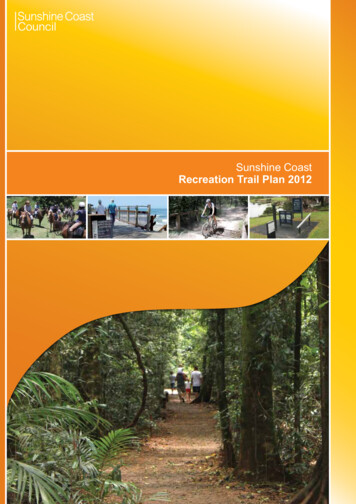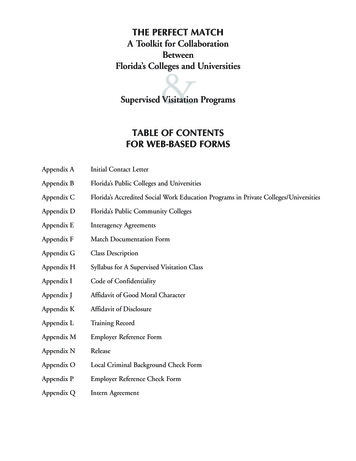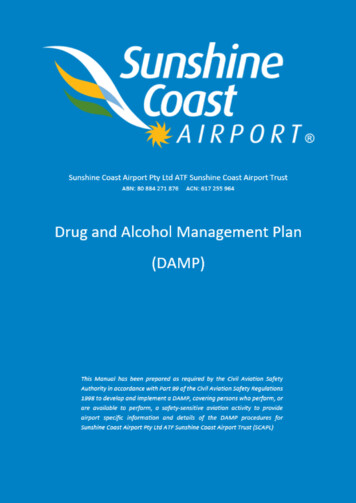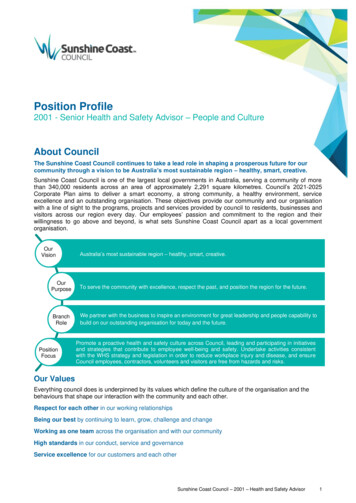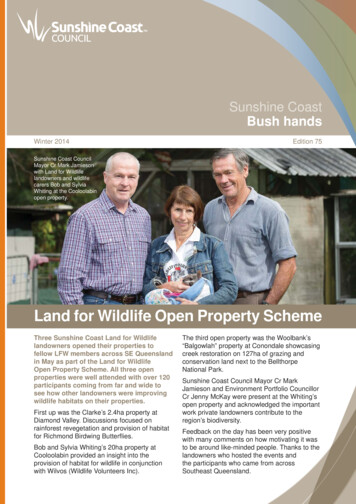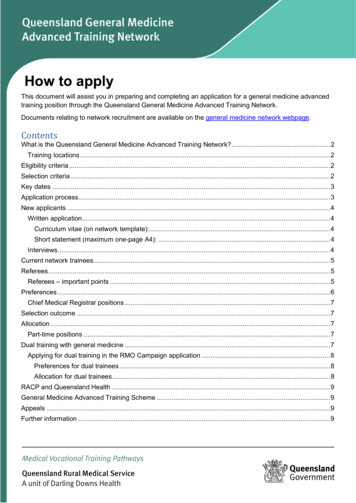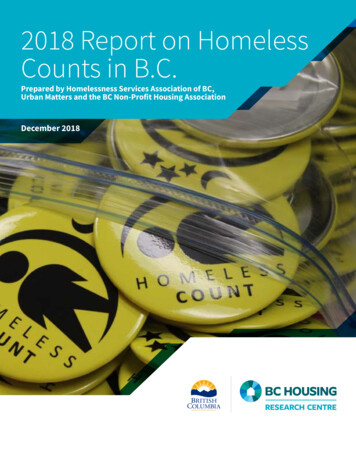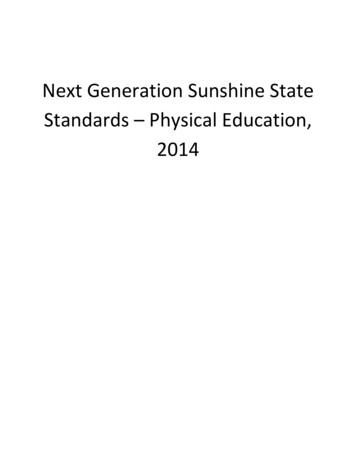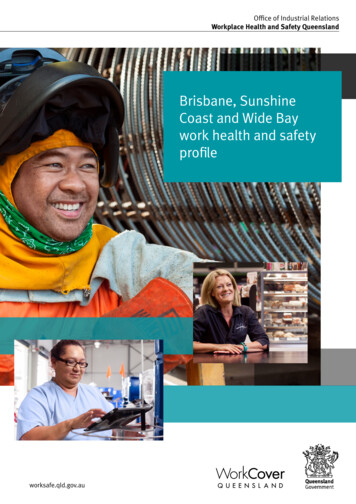
Transcription
Office of Industrial RelationsWorkplace Health and Safety QueenslandBrisbane, SunshineCoast and Wide Baywork health and safetyprofileworksafe.qld.gov.au
2,327,753 people, 20161Population2,495,647 people, BrisbaneAyrMt. IsaGold CoastMackayCentral and North hine Coast& Wide BayRomaGold Coast, Logan andSouth West QueenslandThe Brisbane, Sunshine Coast and Wide BayOffice of Industrial Relations region includes thelocal government areas of Brisbane City, Redland,Sunshine Coast, Noosa, Gympie, Fraser Coast,Moreton Bay, North Burnett, South Burnett,Somerset and Bundaberg.Toowoomba
Brisbane, Sunshine Coast and Wide Bay1,173,200 in 20151,276,200 in 2020 (forecast)Workforce3210,012 businesses39% employing staffBusinesses4Biggest employingindustries5Construction6%Retail tradeProfessional, scientific and technical services9%Education and training9%11%Manufacturing9%Health care and social assistance13%Accommodation and food services7%Public administration and safety8%Other industries23%Transport, postal and warehousing5%Regional projects and future growth6Economic activity Road and rail – Kingsford Smith Drive corridorinner city bypass widening and Wynnum roadcorridor upgrade, Rocklea to Darra upgrade,Gateway Motorway Upgrade North, CaloundraRoad to Sunshine Motorway, Cross River RailProject. It is estimated that the Brisbane, Sunshine Coastand Wide Bay region accounted for around 172billion of the state’s 287 billion gross stateproduct in 2015–16. Airport and Ports – New parallel runway,Dryandra Drive road upgrade, Port of Brisbanemotorway. Over the period 2010–11 to 2015–16, the averageannual growth in real gross regional product inthe region was 2.9 per cent per annum, abovethe state average of 1.6 per cent per annum. National Broadband Network.Footnotes: 1. Estimated resident population as at June 2016. Source: ABS Cat. 3218.0 Regional Population Growth, Australia. 2. Population projection based onmedium series, Queensland Government population projections, 2015 edition. 3. Source: Australian Government Department of Employment, Small Area LabourMarkets Australia Dec 2016. 4. Source: ABS 8165.0 Counts of Australian Businesses, including entries and exits (2015-16). 5. Source: ABS 2011 Census. 6. Source:2017 Major Projects Pipeline Report, BIS Oxford Economics.
Safe and healthy workplacesPrevention is betterReturn to work strategiesEffective management of health and safety risks atthe workplace is a legal requirement and a smartway to do business. Benefits include: Engage the worker in return to work planning assoon as practicable following an injury. reduced workers’ compensation premiumsand claims increased worker productivity improved quality of service provision reduced outlays in recruiting and trainingnew staff reduced costs as a result of unplanned absences improved workplace culture and worker morale improved organisational reputation.To prevent injury, illness or death in the workplace,all physical, mental and emotional risks must beidentified and managed. This is achieved throughwork health and safety management systems,strong leadership and a positive workplace culturethat supports worker consultation, communicationand continuous improvement.Returning to work as soon as possibleafter an injuryResearch shows workers who return to good workas part of their rehabilitation experience a fasterrecovery. Long term work absence, work disabilityand unemployment generally has a negative impacton a worker’s health and wellbeing. Understand the worker’s physical andpsychological capacity as they recover from theirinjury. Develop a personalised suitable duties plan thatreflects the worker’s level of skill and experienceto allow them to recover in the workplace. Support the worker’s rehabilitation throughcollaboration with the insurer and their treatingpractitioner/s.Data and information in this reportClaims, claim rate and statutory cost data is basedon an average of 2013-14 to 2015-16 workers’compensation data.Industry sector data is from the QueenslandEmployee Injury Database and based on acceptedworkers’ compensation claims 2013-14 to 2015-16.The ‘common causes’ and ‘things to consider’ in theindustry sector pages of this report reflect the mostfrequent workers’ compensation claims. Personsconducting a business or undertaking have a dutyto manage all risks in the workplace to ensure thehealth and safety of their workers. For detailedguidance on managing workplace risk, visitworksafe.qld.gov.au.Supporting workers to get back to work as earlyand safely as possible, also allows employers torestore their operational requirements and minimiseclaim costs that impact their workers’ compensationpremium.The best rehabilitation outcomes are achieved whenthe return to work process is commenced as soon aspossible after the worker has sustained an injury.4Brisbane, Sunshine Coast and Wide Bay work health and safety regional profile
High risk industriesThe table below shows the industry sub-sectors of the Brisbane, Sunshine Coast and Wide Bay region thathave the highest number of workers’ compensation claims and typically high claim rates. The claim rates arehighest when the number of claims are high and the workforce is small.IndustryNumberof claims(3 yr av.)Industryshare ofregionalclaimsRegionalindustryclaimsshareof stateindustrytotalQld claimrate(claimsper 4.7Hospitals1,8785.5%62.6%41.6Preschooland schooleducation1,8425.4%56.0%32.2Accommodationand foodservices1,5344.5%54.4%20.7Residential careservices1,3433.9%59.3%55.0Food tal productmanufacturing1,1983.5%48.5%185.1Other storebased retailing1,1153.3%54.3%15.5Road osts(For the 3yr period) 37.2million 17.3million 12.7million 9.0million 9.0million 7.3million 6.8million 7.8million 17.3millionAveragestatutorycosts perclaimFinalreturnto workrateFocus area 13,49495.8%Buildingstructure,installation andcompletionservices 9,20097.7%Hospitals 6,89599.0%Preschooland schooleducation 5,87495.8%Cafes,restaurants andtake away food 6,70996.2%Aged care 5,96297.0%Meat andmeat productmanufacturing97.7%Structuralmetal productmanufacturing 7,02695.4%Hardware,building andgarden supplies 16,20893.6%Road freighttransport 5,709Note: Claims, claim rate and statutory cost data based on the average of three years data 2013/14 to 2015/16. Industries are ordered from highestnumber of claims to lowest with focus areas listed by two digit ANZSIC classifications where the highest number of claims originated.5
Construction servicesBusinesses that mainly supply services for land development and site preparation, building structure, buildinginstallation, building completion and other construction services.Main occupations: electricians, plumbers, labourers, carpenters and joiners.IssueCommon causesSome things to considerManual tasksMaterial and objectsDesign and layout of work areasEquipmentChoice of materialsEquipment and mechanical aidsSafe systems of workManual tasks risk management trainingSlips, trips andfallsStriking objectsTraffic and groundsurfacesDesign and maintenance ofwork areas, walkways, stairs and rampsLaddersSuitable flooring and footwearTrucks and semitrailersHousekeeping and cleaning7%LightingMetal edgesWork proceduresKnivesExclusion zonesSheet metalTag linesHead/faceShoulder/upper arm7%HammersStruck byobjectsMetal and otherfragments6%BackEye17%2%NeckExclusion zones and guardsLimit onsite drilling and grindingGloves, goggles and otherprotective equipmentExtraction systems/dampeningVehicleincidentsOn-road car incidentsFatigue managementDriver trainingAppropriate schedulingOn-site traffic 10%8%Knee/upper legAnkle/lower legFoot/toes4%10%Predominant injury locations from work related incidents6Brisbane, Sunshine Coast and Wide Bay work health and safety regional profile
HospitalsIncludes facilities and services such as diagnostic, medical or surgical services as well as continuous in-patient medicalcare in specialised accommodation. Also included are facilities that provide training of medical and nursing staff. Doesnot include aged care facilities.Main occupations: medical practitioners such as doctors, anaesthetists, specialist physicians, psychiatrists, surgeons,physiotherapists, occupational therapists, radiologist, psychologists, emergency medicine specialist, nurses, nursingsupport and personal care workers, social workers and midwives.IssueCommon causesSome things to considerManual tasksLifting / moving heavyobjects / peopleAssess patient mobilityFurniture and fittingsTrolleys and handcartsWork area design and layoutPatient handling equipment and proceduresTraining in handlingWork designFalls, trips andslipsSlippery surfacesDesign and maintenance of work areas, walkways, stairs and rampsInternal traffic andground surfacesSuitable flooring and footwearHousekeeping and cleaning practices – keep floors dry, clean and wellmaintained3.5%Adequate and even lightingStruck byobjectsAdult patientsSafe systems of workMoving or operatingequipmentPatient assessmentPatient transfer and restraintproceduresHead/faceShoulder/upper arm15%Worker training1%BackEye27%3%NeckEquipment and mechanical aidsStriking objectsDoorsHeight adjustable equipmentSufficient working spaceTwo-way doors with soft closing andviewing insetsBiologicalhazardsPatients withcommunicablediseasesInfection prevention and controlpractices including personalprotective equipment (PPE)Handling sharpsOccupational vaccinationSafety engineered sharps11%Hand/fingers/thumbSafe handling and disposal of sharpsWrist/elbow/forearm9%9%Knee/upper legWorker trainingHazardouschemicalsCytotoxic drugsDisinfectantsAnaesthetic gasesSafe handling, use and storage ofhazardous chemicalsWorker training4%Foot/toes 3%Ankle/lower legPPEPredominant injury locations from work related incidents7
EducationThis sector includes primary and secondary schools and tertiary institutions such as universities and adult,community, vocational and other educational businesses.Main occupations: teachers, education aids, instructors, sports coaches and fitness instructors, health andwelfare support workers.IssueCommon causesSome things to considerBeingstruckBeing struckwhile handlingheavy items orplay equipmentSafe systems of work, including providing an alternative to workers having to liftheavy objectsBeing struck byanother personEmergency communication and response systemsSufficient number of staff trained in behaviour management and de-escalationtechniquesTraining on equipment useScreening, file flagging and action planning for students known to be aggressiveTraining in behaviour management and de-escalation techniquesSlips,trips andfallsMentalstressSlipperysurfacesInternal trafficand groundsurfacesDesign and maintenance of walkways, stairs and rampsSuitable flooring and footwearHousekeeping and cleaning practices –keep floors dry, clean and well maintainedHazardousobjects on thegroundAdequate and even lightingChallengingbehaviour ofstudentsTraining in work areas19%Shoulder/upper arm6%9%NeckTraining for staff in behaviour managementImplementation of an organisation wideemployee support program (e.g. EAP)Work design / rostersExpectation management / rules in the workplace for interactions with students and parents10%Hand/fingers/thumbUndertaking an assessment of thepsychosocial risksTraining on managing psychosocial risks in the workplaceVehicleincidentsOn-road carincidentsBackEye6%Training and safe work proceduresExternal stairsand walkwaysIncreased workdemands1%Head/faceSafe systems of work9%Wrist/elbow/forearm12% Knee/upper legFatigue managementOn-site traffic managementVehicle maintenance and suitability for tasksand conditionsAppropriate scheduling11%Foot/toes 5%Ankle/lower legDriver education and trainingPredominant injury locations from work related incidents8Brisbane, Sunshine Coast and Wide Bay work health and safety regional profile
Accommodation and food and beverage servicesBusinesses that provide accommodation for visitors, such as hotels, motels and units; also includesrestaurants, cafes and take away food businesses.Main occupations: cleaners, housekeepers, hospitality workers including chefs, waiters and other servers.IssueCommon causesSome things to considerManual tasksHandling furniture andfittingsDesign and layout of work areasMaking bedsSafe systems of workEquipment and mechanical aidsUsing trolleys,handcarts andcleaning equipmentSlips, trips andfallsWet, oily or icy groundsurfacesMoving aroundworkplaceExternal steps andstairwaysStriking objectsFood preparationknivesCuts from glasswareand crockeryDoor collisionsDesign and maintenance of work areas, walkways, stairs and rampsSuitable flooring and footwearHousekeepingLighting2%EyeOn-road car andpushbike incidentsBack4%Keeping knives sharp and stored securely15%Cutting away from the bodyWrapping sharp rubbish before disposalLighting8%Design and layout of work areasVehiclesHead/faceShoulder/upper armFatigue managementDriver trainingAppropriate schedulingOn-site traffic managementVehicle maintenanceSuitability for task and conditionsContact withhot objectsHot water and steamOil and fatAutomated systems wherepossibleWarning signs, lights or stickers17%34%Hand/fingers/thumbServing trays or trolleysWrist/elbow/forearm8%Knee/upper legAppropriate personal protectiveequipment5%Work proceduresNon slip floor surfaces, regularcleaningFoot/toes 4%Ankle/lower legPredominant injury locations from work related incidents9
Residential care servicesBusinesses that mainly provide residential aged care or residential aged care combined with either nursing,supervisory or other types of care.Main occupations: nursing support and personal care workers, aged and disabled carers, welfare and supportworkers, nurses and kitchenhands.IssueCommon causesSome things to considerManual tasksAdult patientsAssess patient mobilityFurniture and fittingsWork area design and layoutTrolleys and handcartsPatient handling equipment and proceduresSlippery surfacesDesign and maintenance of work areas, walkways, stairs and rampsTraffic and groundservicesSuitable flooring and footwearSlips, trips andfallsHousekeepingLightingStriking objectsNeedlesTraining and safe work procedurescovering handling and disposal ofsharpsKnifesProtective equipment, such asglovesHeight adjustable equipmentSufficient working space3%Head/face1%EyeBackShoulder/upper arm18%28%6%NeckAssaulted bypeopleAdult patientsEmergency communicationSufficient number of trainedworkersTraining in aggressive behaviourmanagementHand-over practicesDesign and engineer building andfacilities to reduce riskStruck byobjectsAdult patientsPatient assessmentPatient transfer and w/forearm10%8%Knee/upper legWorker trainingEquipment and mechanical aidsFoot/toes2%5%Ankle/lowerlegPredominant injury locations from work related incidents10Brisbane, Sunshine Coast and Wide Bay work health and safety regional profile
Meat and meat product manufacturingBusinesses that mainly slaughter animals, bone, freeze, preserve or pack meat and manufacture cured andpreserved meats and abattoir by-products.Main occupations: meat, poultry and seafood process workers, meat boners, slicers and slaughterers.IssueCommon causesSome things to considerManual tasksHandling animalparts/productsDesign and layout of work areasKnivesStriking objectsMechanical aids for load handlingTask specific trainingCrates, cartons, boxesetc.Knife sharpening programKnivesExclusion zones and guardsWork proceduresSlips, trips andfallsExternal steps andstairwaysDesign and maintenance of workareas, walkways, stairs and rampsWet, oily or icy groundsurfacesSuitable flooring and footwearAnimal parts /productsKnivesHead/face13%Guarding and extraction systemsBack5%HousekeepingLightingStruck byobjects3%EyeShoulder/upper armPersonal protective equipment18%3%NeckSegregation of rolling stock andworkersCommunication systems and highvisibility clothingContact withhot objectsHot water, steamPipeline marking and insulationPersonal protective equipment –face shield, glovesDesign and layout of work areas21%Wrist/elbow/forearm15%Safe systems of workHand/fingers/thumbFoot/toes3%8%Knee/upper leg5%Ankle/lower legPredominant injury locations from work related incidents11
Fabricated metal product manufacturingBusinesses that mainly forge iron and steel or manufacture structural metal products, metal containers, sheetmetal products or other fabricated metal products.Main occupations: structural steel and welding trades workers and process workers.IssueCommon causesSome things to considerStruck byobjectsMetal and otherfragments and dustEquipment designed for the taskMetal including bars,beams, rods etc.Guarding and handlesProtective equipmentInductions, training and supervisionManual tasksHandling metal,materials and objectsDesign and layout of work areasOverhead cranes, hoists, jigs, roller systemsTask specific trainingStriking objectsSlips, trips andfallsBeing trappedMetal edgesEquipment designed for the taskPowered toolsProtective equipmentHammers and malletsInductions, training andsupervisionEye6%Head/faceHazardous objects ongroundDesign and maintenance of work areas,walkways, stairs and rampsTraffic and groundsurfacesSuitable flooring and footwearLightingSteel plates, beams,bars, pipes etc.Exclusion zones and safe workprocedures1%7%Emergency proceduresSafe systems of workNeckShoulder/upper armPreventive maintenanceDesign and layout ofwork areasBack14%HousekeepingTrucks and thumbFoot/toes2%9%5%Knee/upper leg6%Ankle/lower legPredominant injury locations from work related incidents12Brisbane, Sunshine Coast and Wide Bay work health and safety regional profile
Other store-based retailingBusinesses that include furniture, floor coverings, houseware, electrical and electronic goods, hardware,building and garden supplies, clothing, footwear and personal accessories, department stores, recreationalgoods retailing.Main occupations: checkout operators, sales assistants, building and plumbing labourers, retail supervisorsand storepersons.IssueCommon causesSome things to considerManual tasksMoving/lifting, boxes,crates, cartons,freight, stock, food etc.Safe design and layout of storage areas and customer display areasUsing roll cagesElectric pallet jacks and trolleysTask varietySafe systems of workSlips, trips andfallsSlippery groundsurfacesInternal traffic andground surfacesExternal steps andstairsStriking objectsMetal edgesDesign and maintenance of work areas, walkways, stairs and rampsSuitable flooring and footwearAdequate and even lightingHousekeeping and cleaning practices – keep floors dry, clean and wellmaintained2%Machine guardingTimberHeight adjustable equipmentKnivesSufficient working spaceAccess to shelving and storageEyeHead/face5%12%Shoulder/upper armLightingBack24%3%NeckKeeping knives sharp and storedsecurelySafe work procedures(e.g. cutting away from the body)Training and supervisionStruck by objectFalling/droppedcrates, cartons, boxes,cases etc.Racking or storage that ensuresitems cannot be stacked too highLimit stock kept on siteSuppliers to ensure palletsare made up and thumbFoot/toes5%9%8%Knee/upper leg7%Ankle/lower legPredominant injury locations from work related incidents13
Road transportBusinesses that transport freight or passengers by road.Main occupations: truck, bus, coach and automobile drivers.IssueCommon causesSome things to considerManual tasksOperating busesDesign of depot and customer sitesWorking on or aroundtrucks and semitrailersSeating designMechanical aids for load handlingScheduling and work proceduresManual task risk management trainingFallsEntering /exiting orworking on trucks andbusesSteps, hand holds and surfacesWork procedures and trainingHousekeeping and uck, semi-trailer andcar on-road incidentsDriver trainingAppropriate schedulingFatigue managementHead/faceBack6%21%14%Shoulder/upper armOn-site traffic managementStruck byobjectsTruck doorsEquipment design and trainingTruck loadsExclusion zones and trafficmanagementLoad straps fastenersStriking objectsHitting truck/lorryExclusion zones and trafficmanagementEquipment design – particularlyload securing equipmentHearing lossVehicle and road noiseEngineering solutionsProtective %9%Knee/upper legFoot/toes 4%9%Ankle/lower legPredominant injury locations from work related incidents14Brisbane, Sunshine Coast and Wide Bay work health and safety regional profile
Joint prioritiesSafe Work Australia works with all Australian jurisdictions to identify industries for national focus onprevention activities. With few exceptions, these national priority industries also have high claim rates in allregions of Queensland.The national priority industries include: Construction Transport, postal and warehousing Manufacturing Agriculture, forestry and fishing Health care and social assistance Accommodation and food servicesDetailed statistical information for each industry is available in the statistical updates available at:worksafe.qld.gov.au.Industries include: Accommodation and food services Other services Administrative and support services Professional, scientific and technical services Agriculture, forestry and fishing Public administration and safety Arts and recreation Rental, hiring and real estate services Construction Retail trade Education and training Transport, postal and warehousing Electricity, gas, water and waste services Wholesale trade Financial and insurance services Health care and social assistance Information, media and telecommunicationservices Manufacturing15
Find us onWorkplace Health and Safety QueenslandWorkCover Queenslandworksafe.qld.gov.au1300 362 128workcoverqld.com.au1300 362 128State of Queensland 2017.Unless otherwise noted, this document is available under a Creative Commons Attribution 4.0 International Licence (https://creativecommons.org/licenses/). You are free to copy andredistribute the work, so long as you attribute The State of Queensland. The material presented in this publication is distributed by the Queensland Government for information only andis subject to change without notice. The Queensland Government disclaims all responsibility and liability (including liability in negligence) for all expenses, losses, damages and costsincurred as a result of the information being inaccurate or incomplete in any way and for any reason.PN12237
Sunshine Coast & Wide Bay Health care and social assistance 13% 210,012 businesses 39% employing staff Brisbane, Sunshine Coast and Wide Bay 1,276,200 in 2020 (forecast) 1,173,200 in 2015 . Long term work absence, work disability and unemployment generally has a negative impact
